You are using an out of date browser. It may not display this or other websites correctly.
You should upgrade or use an alternative browser.
You should upgrade or use an alternative browser.
one carb per cyl - various falcon motors
- Thread starter chad
- Start date
 Wow very nice and it looks Just right on that 2V head.
Wow very nice and it looks Just right on that 2V head. 
I didn't need to modify the head for the swap. All I did was make the aluminum flanges line up with the ports on the 250-2v. Then I just modified the carb linkage to match.
I have not had a chance to fool with the jetting. I have to replace one of the fuel line lines before testing. I did wire in a wideband to aid in the process.
I also had to build the filters. I ended up using KN filter and found one on their website by searching the dimensions. The oval filters are originally for a Mini 1.3L.
I have not had a chance to fool with the jetting. I have to replace one of the fuel line lines before testing. I did wire in a wideband to aid in the process.
I also had to build the filters. I ended up using KN filter and found one on their website by searching the dimensions. The oval filters are originally for a Mini 1.3L.
NB// Soldering and pilot drilling twelve idle jets will get you close in this instance. Since the dischage rate goes haywire when you custom drill a jet, you have to swap six similar jets. The discharge chamfer defines flow rate, not so much drill size. Holley adjust the camfer to adjust flow rates in some cases. Then start lean with the first six idle jets, and keep opening them with another bigger size drill untill it doesn't idle as well. Start at 40 thou.
Then go back with the other 6 jets, and drill to the size that worked best.
Then find a Mikuni jet that discharges the same rate. Take the six driiled jets, hook them up to a Ford washer bottle with 50% Windex water solution.
https://www.reference.com/science/chemi ... 3b9f940d63
Specific gravity: 0.996 is close to water at 60 degrees F
MSDA sheet http://www.msanet.com/prism/pdfMSDS/SDSGM/10272.pdf
Gasoline kills the washer motor, and water doesn't flow like gas.
Then squirt into a known ounce cup, and time untill full. 45 psi is the normal delivery pressure for this test, and the normal curves for flow are in water injection publications. http://www.aquamist-direct.com/806-063- ... pwm-valve/
Aquamist use pulse width modulation, so it isn't the same as it flows 2.4 times the rate of a Holley jet the same size.
but it gives you the idea.
Compared to Holley jets, a 47 thou (1.2 mm) jet at 45 psi with PWM (200 Hz cycles per second Pulse width Modulation) flowing methanol flow huge rates...its 400 cc/min, while Holley quote 171 cc/min using there test method with 0 .786 SG gasoline.
Tested my way, with Unchamfered holes, a 15.74 thou hole (0.40 mm) flows about 25 cc's per minute, or near to 25 mililiters per minute at 45 psi for. Its pretty well difficult to go below that size unless you have access to jewlers cutting tools.

Gauging is not the right way, but its good for a start. Then use your smarts, and do direct flow measurement in a way that suits YOU.
See http://www.speedtalk.com/forum/viewtopic.php?p=7172
The normal flow rates for hole size verses cc/min are
http://vb.foureyedpride.com/editpost.ph ... o=editpost
Find the average of the six jets you've drilled that give a good idle, and then find the same six Mikuni idle jets with the same flow rate. Mikunis quality control is awesome.
There are around 2500 jet combinations, this eliminates the search in a few sessions of idle checks.
K&N Mini/Midget 1275 dual SU air cleaner. 56-9055 or 11 4014.
Nice. The air cleaner helps draw air flow from the outer regions about the carb.
Been around A series since Day one. Morris Minor.....two ClubMans 998/1098, Mark II 998. How such an inefficent dawg can make 100 hp per liter at 7000 rpm is beyound me.
Tuning For Speed by Phil Irving tells you how to tune the Mikunis. Jack Collins old posts focused on how many potential resident idle circuit jets there are on such a sensitive set up.

You just assume that it is making way mor vac and is much much richer because of the cam duration reduction and long runs into one intake valve....that means soldering up jets, trial checking, and then buying new ones. You'll get there. Contact Ron Ward and ask him what he ended up using.
https://www.youtube.com/watch?v=YyTHu3NkQIE
https://www.youtube.com/watch?v=1-EVAnY7WKQ
Then go back with the other 6 jets, and drill to the size that worked best.
Then find a Mikuni jet that discharges the same rate. Take the six driiled jets, hook them up to a Ford washer bottle with 50% Windex water solution.
https://www.reference.com/science/chemi ... 3b9f940d63
Specific gravity: 0.996 is close to water at 60 degrees F
MSDA sheet http://www.msanet.com/prism/pdfMSDS/SDSGM/10272.pdf
Gasoline kills the washer motor, and water doesn't flow like gas.
Then squirt into a known ounce cup, and time untill full. 45 psi is the normal delivery pressure for this test, and the normal curves for flow are in water injection publications. http://www.aquamist-direct.com/806-063- ... pwm-valve/
Aquamist use pulse width modulation, so it isn't the same as it flows 2.4 times the rate of a Holley jet the same size.
but it gives you the idea.
Compared to Holley jets, a 47 thou (1.2 mm) jet at 45 psi with PWM (200 Hz cycles per second Pulse width Modulation) flowing methanol flow huge rates...its 400 cc/min, while Holley quote 171 cc/min using there test method with 0 .786 SG gasoline.
Tested my way, with Unchamfered holes, a 15.74 thou hole (0.40 mm) flows about 25 cc's per minute, or near to 25 mililiters per minute at 45 psi for. Its pretty well difficult to go below that size unless you have access to jewlers cutting tools.

Gauging is not the right way, but its good for a start. Then use your smarts, and do direct flow measurement in a way that suits YOU.
See http://www.speedtalk.com/forum/viewtopic.php?p=7172
R.Brown":1iq430m4 said:» Post Fri May 20, 2005 11:10 am. I have flowtested all types of jets, and have used many different methods. I found with the difference approach and exit angles on the jets that pin gauging them did not lead me in the right direction. You can to it for dirt cheap if you have a gram scale, and a stop watch, and some type of a fuel pump. Build a jig to hold a jet, make the entry and exit angles in the jig as large as possible so you do not influence the flow of fuel to the jet, then machine in a pressure tap right at the upstream side of the jig, near the jet. Plumb the tap to a 0-15 PSI gauge. Run the pressure to 6PSI, or whatever you dream up for head pressure. I use stoddard solvent .786 SG fluid. Get the jet flowing at the right pressure into one container on the bench, and have another sitting on the scale. Start the stop watch and move the hose into the container on the scale simultaneously. Flow for 1 minute. Record the weight.
I wrote a simple excel program to do the math, type in the weight and it converts to lb/hr.
This worked well when I was trying to prove to myself that this was a worthy endeavor. Now I sell over 500 flow tested main jets a year, so I built a flow stand with a high dollar flowmeter and a "quicker" way of testing, but the results are the same... just takes one tenth the time.
Feel free to ask any other questions about this, although I do not get a chance to surf very often these days. You can email me directly thru the link at:
http://www.ryanbrownracing.com
The normal flow rates for hole size verses cc/min are
http://vb.foureyedpride.com/editpost.ph ... o=editpost
xctasy":1iq430m4 said:the chart that shows all them plotted. Disregards the units. The chart should read 150 microns is 1.5 mm
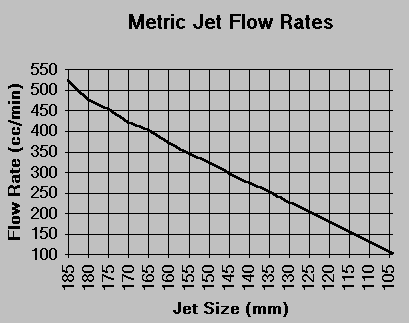
And specifically:The earlier standard jet sizes for Holley Webers are:-
103 cc/min=105 microns, or 41.34 thou
128 cc/min=110 microns, or 43.31 thou
152 cc/min=115 microns, or 45.28 thou
178 cc/min=120 microns, or 47.24 thou
201 cc/min=125 microns, or 49.21 thou
225 cc/min=130 microns, or 51.18 thou
251 cc/min=135 microns, or 53.15 thou
275 cc/min=140 microns, or 55.12 thou
298 cc/min=145 microns, or 57.09 thou
325 cc/min=150 microns, or 59.06 thou
346 cc/min=155 microns, or 61.02 thou
375 cc/min=160 microns, or 62.99 thou
400 cc/min=165 microns, or 64.96 thou
425 cc/min=170 microns, or 66.93 thou
450 cc/min=175 microns, or 68.90 thou
475 cc/min=180 microns, or 70.87 thou
525 cc/min=185 microns, or 72.83 thou
Find the average of the six jets you've drilled that give a good idle, and then find the same six Mikuni idle jets with the same flow rate. Mikunis quality control is awesome.
There are around 2500 jet combinations, this eliminates the search in a few sessions of idle checks.
K&N Mini/Midget 1275 dual SU air cleaner. 56-9055 or 11 4014.
Nice. The air cleaner helps draw air flow from the outer regions about the carb.
Been around A series since Day one. Morris Minor.....two ClubMans 998/1098, Mark II 998. How such an inefficent dawg can make 100 hp per liter at 7000 rpm is beyound me.
Tuning For Speed by Phil Irving tells you how to tune the Mikunis. Jack Collins old posts focused on how many potential resident idle circuit jets there are on such a sensitive set up.
You just assume that it is making way mor vac and is much much richer because of the cam duration reduction and long runs into one intake valve....that means soldering up jets, trial checking, and then buying new ones. You'll get there. Contact Ron Ward and ask him what he ended up using.
https://www.youtube.com/watch?v=YyTHu3NkQIE
https://www.youtube.com/watch?v=1-EVAnY7WKQ
Oldsix and others. I like IR/POP. Not Igy Pop. Although slam dancing and crowd walking and getting naked on stage was I guess a progression in rock.
IR/POP = Independent Runner, Port on Port.
On Big engines, its a waste of time because of how much space it takes up.
This is not an they follow Appollus, I follow Paul, all others are wrong preach. Its about what works in systems, and if that means people are gonna blend philosphies, well that's on them.
For the record,
I'm straight down the line with Jeremy Diamond/Panics synopsus of big IR systems. They drop out as being practical from a packaging point of view on big engines.
I'm an Ak Miller advocate, he started out on the crazy Glasspar G2 Special with a "352" stroker 283 Chevy with 4" bores, 3.5" stroker crank, and six Deuce Stromberg 97's for 315 flywheel horspower net
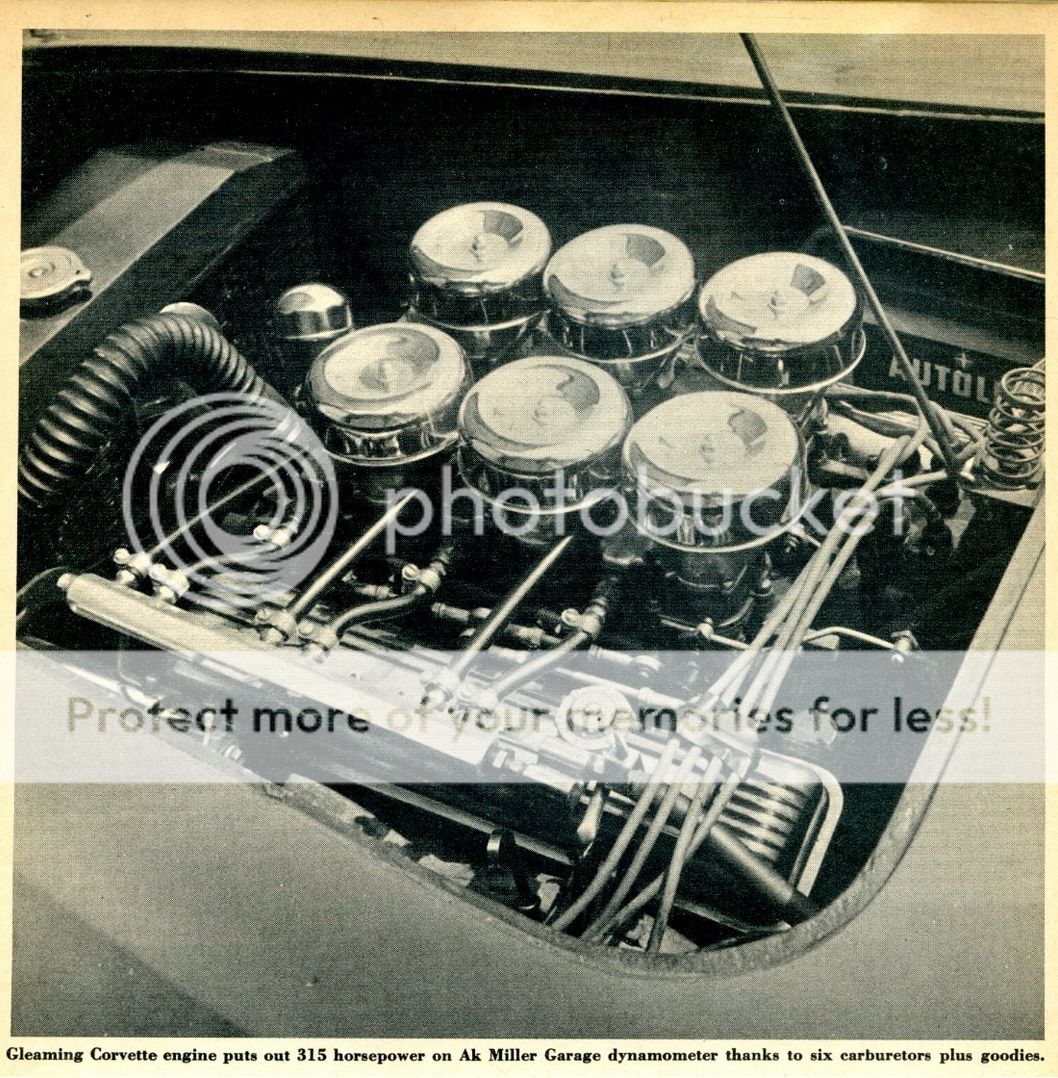


That's Twelve 23.8 mm venturis of 15/16ths, or 8.28 sq inches of carb venturi area on a 352 cube engine.
42 cubes of engine for every sqaure inch of carb. He made 972 cfm at 1.5'Hg work within the confines of the low hood. 162 cfm of Stromberg 97 2-bbl, six times. 229 cfm at 3" Hg each.
Miller was a six cylinder kind of guy generally, but was a total V8 die hard in terms of aspiration, and although his Four Keihin 37 mm carb 1967 Mustang fit up yielded 158 flywheel hp from just a mildly cammed and headered 200 six, it was actually a Port on Port on the outer carbs (feeding cylinders 1 and 6 via an offset 1-1/2" pipe, and One venturi per 2 cylinders feeding 2, 3, 4, 5). That's why it had some issues with a flat spot off idle.
Pure IR/POP systems have the most docile idle of any carb system, as well as the most potential power and torque. Less than port on port, you have to do some artificial freshing of the system, that's where Power Valves, accelerator pumps and sequential throttle modulation come in, but its a crutch. Pure IR/POP systems when tuned for venturi size at wide open throttle, are always the best out of the box.
WDoug72, you've got it going on, and your system answers the packaing issues. If you can get the carbs and offset the fresh cost if any other sucker was doing it from scratch, all good!
This is not an anti IR/POP tirade, its a point that IR/POP is actually really nice to the carb flow, in the same way Port EFI is nice to each intake runner flow. A good multiple Carb system that is less than Port on Port, like, say, a Triple 1-bbl In line six, can make just as much power and torque, but to do so requires very spacial work on cam timing. One venturi per 2 cylinders is where I'm at, and that's based on cost and space, and the Hot Rod US developments that Ak championed. I think that the Shelby and Ford Total Performance era found other Holley and some ill fated Autolite systems eventually proved that Independent runner, Port on Port systems could be beaten only by better manifold design and carb modulation.
But the misconception is this over IR/POP.
http://www.timsroadster.com/html/tuning_webers.html
IR/POP = Independent Runner, Port on Port.
On Big engines, its a waste of time because of how much space it takes up.
This is not an they follow Appollus, I follow Paul, all others are wrong preach. Its about what works in systems, and if that means people are gonna blend philosphies, well that's on them.
For the record,
I'm straight down the line with Jeremy Diamond/Panics synopsus of big IR systems. They drop out as being practical from a packaging point of view on big engines.
I'm an Ak Miller advocate, he started out on the crazy Glasspar G2 Special with a "352" stroker 283 Chevy with 4" bores, 3.5" stroker crank, and six Deuce Stromberg 97's for 315 flywheel horspower net



That's Twelve 23.8 mm venturis of 15/16ths, or 8.28 sq inches of carb venturi area on a 352 cube engine.
42 cubes of engine for every sqaure inch of carb. He made 972 cfm at 1.5'Hg work within the confines of the low hood. 162 cfm of Stromberg 97 2-bbl, six times. 229 cfm at 3" Hg each.
Miller was a six cylinder kind of guy generally, but was a total V8 die hard in terms of aspiration, and although his Four Keihin 37 mm carb 1967 Mustang fit up yielded 158 flywheel hp from just a mildly cammed and headered 200 six, it was actually a Port on Port on the outer carbs (feeding cylinders 1 and 6 via an offset 1-1/2" pipe, and One venturi per 2 cylinders feeding 2, 3, 4, 5). That's why it had some issues with a flat spot off idle.
Pure IR/POP systems have the most docile idle of any carb system, as well as the most potential power and torque. Less than port on port, you have to do some artificial freshing of the system, that's where Power Valves, accelerator pumps and sequential throttle modulation come in, but its a crutch. Pure IR/POP systems when tuned for venturi size at wide open throttle, are always the best out of the box.
WDoug72, you've got it going on, and your system answers the packaing issues. If you can get the carbs and offset the fresh cost if any other sucker was doing it from scratch, all good!
This is not an anti IR/POP tirade, its a point that IR/POP is actually really nice to the carb flow, in the same way Port EFI is nice to each intake runner flow. A good multiple Carb system that is less than Port on Port, like, say, a Triple 1-bbl In line six, can make just as much power and torque, but to do so requires very spacial work on cam timing. One venturi per 2 cylinders is where I'm at, and that's based on cost and space, and the Hot Rod US developments that Ak championed. I think that the Shelby and Ford Total Performance era found other Holley and some ill fated Autolite systems eventually proved that Independent runner, Port on Port systems could be beaten only by better manifold design and carb modulation.
But the misconception is this over IR/POP.
http://www.timsroadster.com/html/tuning_webers.html
There are some common misconceptions about Weber IDAs. I recall when I was designing the motor for my Cobra replica I was talking to a gentleman who is very highly regarded in the industry about my carburetion options. I told him that I was considering Weber IDAs. He was very adamant that the IDAs were a poor choice and went on to explain why. For my application (a 331 stroker small block Ford) the “traditional” carburetor might be a Holley 650 CFM four barrel. This carb has 4 bores that are approximately 43mm in diameter. A Weber IDA system for the same motor might use 8 bores that are maybe 40mm in diameter. He explained that the Webers would fall flat on their faces when nailing the throttle because they would suddenly be opening up nearly twice the throttle area of the Holley 4-barrel. This, he reasoned, would kill air velocity and therefore performance.
At first glance, his reasoning seems sound. But it’s actually not, and the reasons become clear if you think about it a little bit more. A motor demands air only one cylinder at a time. In a traditional 4-barrel setup, the carb is essentially only serving one cylinder at a time, and each cylinder “sees” all 4 barrels plus the entire manifold at WOT. In essence, this is just the opposite of what the expert explained to me. An engine with conventional carb sees far more area when the throttle is nailed than an engine with Webers. Consider an IDA on an individual runner. Each cylinder only “sees” its dedicated barrel and a very short manifold runner. It certainly doesn’t “see” any of the other independent barrels. This results in a very fast-moving air charge. Torque is a highly dependent on air velocity and high velocity increases torque. Since the runner is so short, the air can get moving very quickly, increasing throttle response. There is a reason that the Weber IDA on an independent runner manifold was the carburetor of choice for race cars prior to the advent of fuel injection. It provided the best torque, and throttle response – essential for a race car.
chad":3236grww said:agreed Econo.
Tuning (syncronising) them is no big deal with a hose, but there is a gadget called the Unisyn that takes all the guesswork out of the job.
But now I hear there's a Carter YH side draft (an early '60s thru '66 I've heard) that's reliable (just so many sizes it's hard to assure/ID the right one) used on early vetts too.
"...thought it may be helpful…"
Not ramblin. Like I said, it ALL helps !!!
The YH was never an Independent runner carb, but it was found on Stovebolt 53-55 Chevy Blue Flame Corvettes in one carb per two cylinder form, and on all the old Slant Six Dodge/Mopar forklift and stern drive boat engines, and many little Ford six boat engines too

can the main jet @ .802 tell us anything about how this YH might perform a sextet on our motors? (or R we back to trips but side draft)?
U or Mike's Carbs sez this Carter wuz used on 'Vetts - 1 per 2 cylinders...
Is it a good option for the "1 per cyl" falcon motor? if so which of the 6 motors...
"...many little Ford six boat engines..."
U or Mike's Carbs sez this Carter wuz used on 'Vetts - 1 per 2 cylinders...
Is it a good option for the "1 per cyl" falcon motor? if so which of the 6 motors...
"...many little Ford six boat engines..."
Its a little to big to fit on the passenger side, but if its "rib-caged" with a six fingered Paul Knott style 61 Falcon 170 steel tubes to the log head, then you'll get six of them fairly easily on the drivers side. You support the whole shebang on some metal supports so the carbs don't fall off over the the bumbs of AirBorne Early Bronco Busting trail journey's
Tuning wise, its easy. Blackhawk make custom Metering rods (which are basically the wacky YS/YF/ WCD Carter Shepards Crook brass rods), and that's all you need to make them work. A source of six carbs the same, most likely from the 225 Forklift Mopar engines. The venturi and choke size would iIMHO be right on target. The pump calibration and details, well its just ball bearings and springs, and as long as the dreaded ethanol gas hasn't etched the Zinc Oxide, your good to go.
Tuning wise, its easy. Blackhawk make custom Metering rods (which are basically the wacky YS/YF/ WCD Carter Shepards Crook brass rods), and that's all you need to make them work. A source of six carbs the same, most likely from the 225 Forklift Mopar engines. The venturi and choke size would iIMHO be right on target. The pump calibration and details, well its just ball bearings and springs, and as long as the dreaded ethanol gas hasn't etched the Zinc Oxide, your good to go.
chad":2s6kt8o4 said:can the main jet @ .802 tell us anything about how this YH might perform a sextet on our motors? (or R we back to trips but side draft)?
U or Mike's Carbs sez this Carter wuz used on 'Vetts - 1 per 2 cylinders...
Is it a good option for the "1 per cyl" falcon motor? if so which of the 6 motors...
"...many little Ford six boat engines..."
Just fine. Jetting goes crazy big when its Independent Runner, so the Corvette YH jetting might be in fact a little too small on a six YH Carter engine designed for 250 hp or more. Two YH's fed the common Y block 292/312 Interceptor V8's from the late 50's, early 60's.
viewtopic.php?f=1&t=77062
chad":2s6kt8o4 said:I grew up on the Chesapake Bay (1952 - '80) and saw some teake, mahogony and brass outfitted "skiffs" with motors
like those in the area. I wonder if there is a connection. The engine pictured is the 200?
Yes, the connection is this.

While YH Carter was used on all the sports Corvairs, Corvette L6's, the Nash Healy, and then later Marinised Slant sixes and, IIRC, the later Clark and Hyster Forklifts. Due to space limitations of the Tea Pot 4-bbl carbs, Y blocks wouldn't fit boats easily. So Interceptor cobbled up the YH Carter to fit in the lowest slung intake manifold ever.



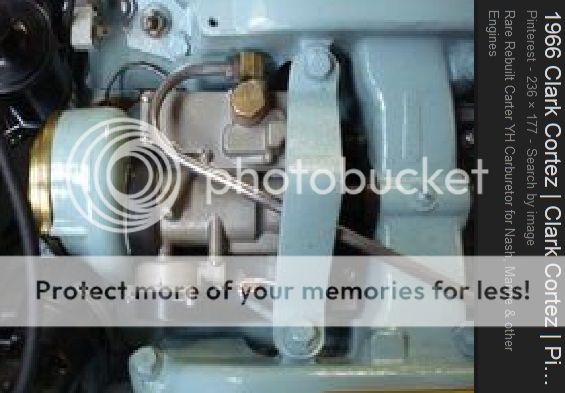
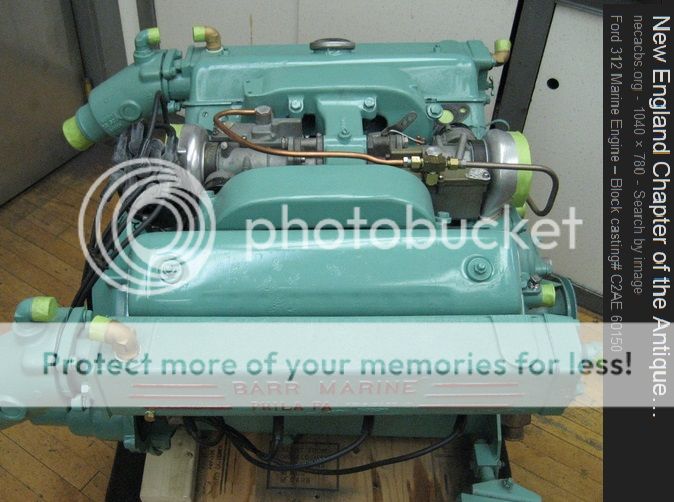


Interceptor "Eaton" Inboard I/0 engines till about 1964,the Ford I6's and the Y block V8's all had YH's in single of dual form.
(Note Well Interceptor opted out of the YH Carter totally when the 221 V8 came in for 1962,


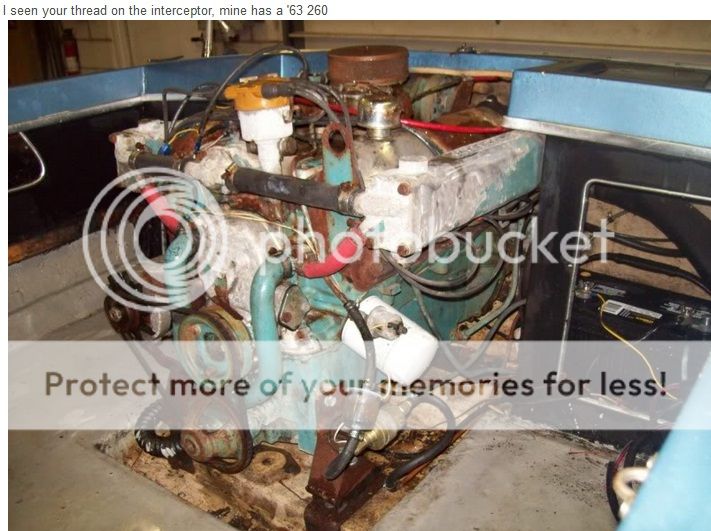
but that engine was very compact; one YH Manifold was made for the 221, and the planned Sunbeam Tiger and Interceptor SBF V8'S. Fords Autolite 2-bbl carbs were small enough to just fit under the engine covers or hoods)
yh don't even look like a carb (to this non-mechanic)
the boar is BESIDE the bowel
It helps create it's own 'cross-flow' on that motor,
avoids the 60s/70s low hood issue on fords (in bent8 only I guess)
&, as stated - would need to B in the 'ribs' style (or other 'remote')
as will not fit against inner fender/shock tower in our rigs ('60 falcon -
'82 Zepher'n fox bodied).
May B need 2 or 3 on a 250 or 300 w/that jeting...?
the boar is BESIDE the bowel
It helps create it's own 'cross-flow' on that motor,
avoids the 60s/70s low hood issue on fords (in bent8 only I guess)
&, as stated - would need to B in the 'ribs' style (or other 'remote')
as will not fit against inner fender/shock tower in our rigs ('60 falcon -
'82 Zepher'n fox bodied).
May B need 2 or 3 on a 250 or 300 w/that jeting...?
ludwig":3um9q53j said:I wonder why that low-slung big block never caught on? That would make an awesome street fighter. And what a conversation piece when you pop the hood.
X-man - you need to collate all this arcana. What a trove of cool stuff!!!
I wouldn't worry about it...Automotive Historians do this kinda stuff often.Its Out There if you wanna dabble.....


https://www.youtube.com/watch?v=AuhKPyhdqKE
The Dearborn Marine Interceptors were exy little engines. 215 HP gross in the 312 wasn't much chop compared to a Fuelie 327, so evn though they were built to 1964, the Y's were glorious looking, expensive anachronisims.
http://m571.com/yblock/intake.htm
http://m571.com/yblock/intake.htm":31zie3w5 said:Interceptor
Interceptor
This marine manifold used Carter YH sidedraft carburetors to keep the installed height to a minimum. Some installations used only one carburetor. YH sidedrafts were also used on turbocharged Corvairs, 215 F85 Oldsmobiles, Corvette “Blue Flame” 6s, and Nash Le Mans 6s. Exhaust heat is passed under the cross runner of this unit.
Interceptor on Thunderbird
This beautiful Interceptor intake installation on a Thunderbird was accomplished by Gary Hartzell of LA Mesa, California.
In Gary’s own words:



“Wanted to do something out of the ordinary. Went to the Goodguys show at Del Mar last weekend (first show) and stumped a lot of Ford know-it-alls!!!!! One guy asked if I had to do anything special to make it run right and I told him I had to fill the radiator with salt water!! I had to fab my own necks to the radiator, but the installation wasn't too difficult at all and the results were well worth it.”
i no they circulated sea water but Y did the auto (T-bird) need to use it?
Went to the link (m571.com) and saw over a doz intakes. Of the Y block I saw our bent8 buddies use "1 per cyl" on three:
Edelbrock FM657
Weaned Dragstar
Offenhauser 3947
that's alotta cfm!
YH used on only 1?
Went to the link (m571.com) and saw over a doz intakes. Of the Y block I saw our bent8 buddies use "1 per cyl" on three:
Edelbrock FM657
Weaned Dragstar
Offenhauser 3947
that's alotta cfm!
YH used on only 1?
Primarily to look cool, and mess up show goers.chad":138pjv9d said:i no they circulated sea water but Y did the auto (T-bird) need to use it?
Really mess them up goood
The Interceptor Y-block intake was born a Marine V8 intake, and had to be converted to a pro street style twin line to fit an automotive Thunderbird 312 Y block.
Back to the YH's....Mopar Slants weren't YH equiped if the engine was mounted at 30 degrees,
http://www.hotrod.com/articles/mopp-111 ... ep-six-001
even if it was canted a further 50 degrees to a wacky 80 degrees, just 10 degrees of being a flat six of sorts.
It still ran the 2-bbl Carter BDB carb.


But the Nash Ambassador Le-Mans was.

More on the single YH carb Interceptor 100 144cube engine



Gray Marine Co. used dual sidedraft Carter YH on the AMC 327 engines
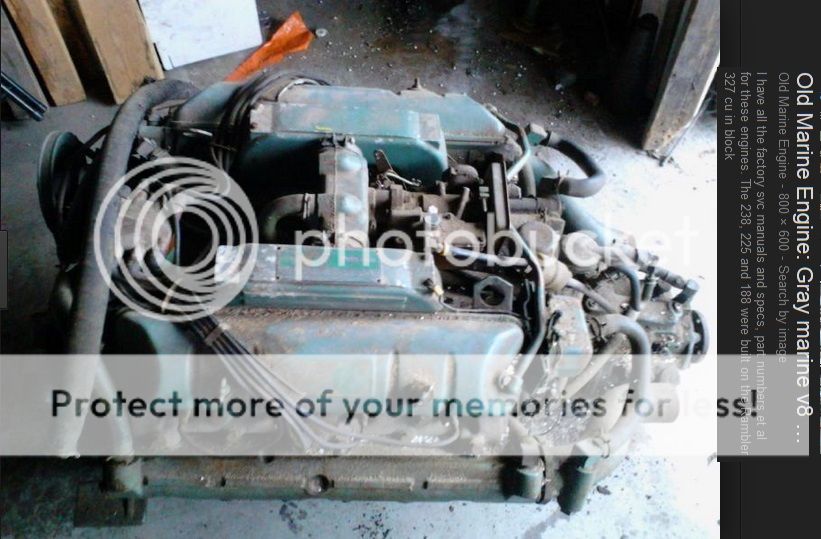
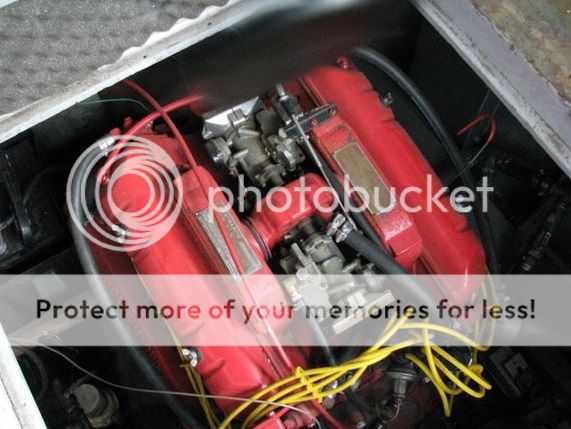


re-viewin da pic in ur #26 post above, X, I C a way 2 use the YH in "1 per cyl".
(They use a side draft like a down draft - to me, anyway. Again may not have the proper nomenclature).
If placed on a 90* adapter (like on the #26 post) the log could B retained. The carbs could B arranged left/right/left, etc all the way down the log.
I believe this may take up abt the same hight as my RBS (or the other low mount carb: 1100) plus___?___ inches.
Linkage? wtf? a buncha cable throttles...
(They use a side draft like a down draft - to me, anyway. Again may not have the proper nomenclature).
If placed on a 90* adapter (like on the #26 post) the log could B retained. The carbs could B arranged left/right/left, etc all the way down the log.
I believe this may take up abt the same hight as my RBS (or the other low mount carb: 1100) plus___?___ inches.
Linkage? wtf? a buncha cable throttles...
chad":2pmvgf5j said:re-viewin da pic in ur #26 post above, X, I C a way 2 use the YH in "1 per cyl".
(They use a side draft like a down draft - to me, anyway. Again may not have the proper nomenclature).
If placed on a 90* adapter (like on the #26 post) the log could B retained. The carbs could B arranged left/right/left, etc all the way down the log.
I believe this may take up abt the same hight as my RBS (or the other low mount carb: 1100) plus___?___ inches.
Linkage? wtf? a buncha cable throttles...

Well you could
1. mount four down low for a start...




Nash Healy had it...a log head with twin YH's

See http://forums.aaca.org/topic/234294-195 ... or/?page=2
The Le Mans duel jet fire motor was offered from 1953 to 1956
Nash built 3 series of cars during the early and mid-fifties; Statesman, Ambassador, and Rambler. Rambler had their own styling; Ambassador and Statesman lines were hard to tell apart.
1955 Statesman Six Dual Carb. Figures same as the standard six but with dual Carter single barrel carbs. Front carb was a YH-973S; rear carb was a YH-974S. Brake hp 110.
1955 Ambassador Six. Inline, OHV. Displacement 252.6 cid. Brake HP Brake HP 130. Carter Single barrel carb YH-895-S. 1955 Dual-Jetfire Six. Displace 252.6 cid. Brake HP 140. Carburetors same as the Statesman Six Dual Carb.
1956 Ambassador Six. Displacement 252.6. HP 135. Carter single-barrel, Type YH-2368S.
1956 LeMans Dual-Jetfire Six. Displacement 252.6. Brake hp 145. 2 Carter Type YH-2396S carbs.
There were single YH Dual Jetfires too


2. Then two up high. (front to back like the 215 Interceptor and the 100 Interceptor).
Carburetor Tag Set, 973S & 974S Originals. 52-55 Nash Ambassador Dual Jetfire
http://www.ebay.com/itm/Carburetor-Tag- ... 1866645557

